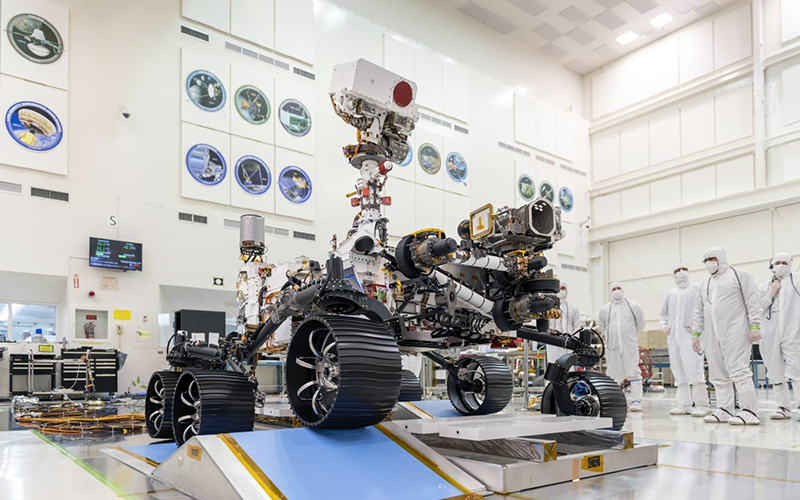
Engineers observe the first driving test for NASA’s Mars 2020 rover on Dec. 17 in a clean room at NASA’s Jet Propulsion Laboratory in Pasadena, California. The so-far unnamed mission is scheduled to launch next summer and touch down on Mars in 2021. (Photo courtesy of NASA/JPL Caltech)
PHOENIX – NASA is sending another rover to Mars to better understand the planet and look for signs of life. If all goes to plan, the mission will be the first to bring samples from Mars back to Earth.
The Mars 2020 rover, which hasn’t been named yet, is about the size of a compact car. It looks similar to the Curiosity rover that’s now exploring the Red Planet because the new rover is made of mostly spare parts. The new mission is scheduled to launch next summer.
The mission has been about five years in the making. Along with getting a better understanding of our neighboring planet, the unnamed rover will also be searching for signs of life and testing conditions to prepare for future human exploration.
The destination is Mars’ Jezero Crater, which once hosted a lake 30 miles in diameter and contains the best possibility for life on another planet this close to Earth.
Ken Herkenhoff, a scientist at the U.S. Geological Survey’s Astrogeology Science Center in Flagstaff, works with the team that created the cameras that will provide a 3-D view of what the rover sees. He called Jezero a promising landing site.
“There’s a lot of craters on Mars,” he said, “and this one looks different from a lot of those craters because it has the delta so we can tell that there was once a river flowing into this lake and then there’s also a channel on the opposite side of the crater where the water drained out. It was filled to capacity and actually overflowed.”
Jim Bell, a professor at Arizona State University’s School of Earth and Space Exploration, is the principal investigator on the project. The main focus of Mars 2020 is to better understand Mars, he said, but scientists hope they’ll also find signs of life.
“We’re looking for the same kinds of things geologists are looking for out on a field sight on Earth where they’re trying to put together both the history of the geology at that place and possibly the history of biology or whether it was an environment that could have supported biology,” Bell said.
A few minerals on Mars are particularly good at trapping past forms of life, known as biosignatures. Because the planet’s surface has been a harsh environment for billions of years, the rover is equipped with a drill attachment to dig for microscopic fossils.
Ryan Anderson is a physical scientist at the Astrogeology Science Center with Herkenhoff. He’s working on the super-cam team and, more specifically, on a laser that will help scientists learn more about the minerals on Mars.
“It just zaps the rock and turns a little tiny bit of it into a spark of plasma, and then it collects the light from the plasma and then you can use that to tell which chemical elements are in the rock,” Anderson said.
From there, scientists will have a better understanding of the chemistry and climate within the ancient lakebed and reveal what kind of life could have survived. The chances of finding evidence of past life are low, but there is a general consensus that if biosignatures are found, a new door would open in the search for extraterrestrial life.
“It’s certainly fun to think about,” Herkenhoff said.
Anderson added, “I think it’s almost certain that there’s life elsewhere in the universe.”
And Bell said, “So it’s not crazy to think that there might even be places in our own solar system where there’s other life out there waiting for us to find it.”
The details of how the samples will make it back to Earth are still being decided, just like the rover’s name. NASA hosted a naming contest with K-12 students and is announcing the winner soon.
The rover is scheduled to launch from Florida next summer and is expected to land in Jezero Crater in early 2021. It will spend about a year on the Red Planet.